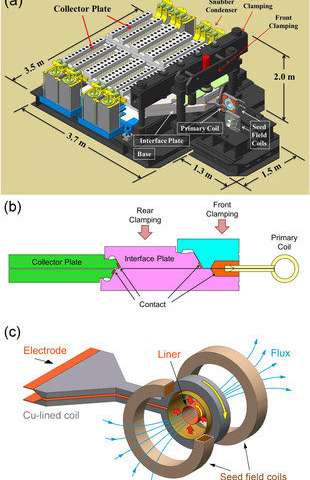A group of scientists at the University of Tokyo has recorded the largest magnetic field ever generated indoors—a whopping 1,200 tesla, as measured in the standard units of magnetic field strength.
By comparison, this is a field strength about 400 times higher than those generated by the huge, powerful magnets used in modern hospital MRI machines, and it is about 50 million times stronger than the Earth’s own magnetic field.
Stronger magnetic fields have previously been achieved in outdoor experiments using chemical explosives, but this is a world record for magnetic fields generated indoors in a controlled manner. That greater control means the discovery could open new frontiers in solid-state physics, perhaps allowing scientists to reach what is known as the “quantum limit,” a condition where all the electrons in a material are confined to the lowest ground state, where exotic quantum phenomena may appear.
The high magnetic field also has implications for nuclear fusion reactors, a tantalizing if unrealized potential future source of abundant clean energy. To reach the quantum limit or sustain nuclear fusion, scientists believe magnetic field strengths of 1,000 tesla or more may be needed.
The experiments that set the new world record are described in an article appearing this week in the journal Review of Scientific Instruments, from AIP Publishing.
Find your dream job in the space industry. Check our Space Job Board »
The work opens up a new scientific horizon, said Daisuke Nakamura, first author on the paper, and “has pushed the envelope for ultrahigh magnetic fields.”
The article “Record indoor magnetic field of 1200 T generated by electromagnetic flux-compression” by D. Nakamura, A. Ikeda, H. Sawabe, Y.H. Matsuda and S. Takeyama appears in the journal Review of Scientific Instruments (2018).
Provided by:
American Institute of Physics
More information:
D. Nakamura et al. Record indoor magnetic field of 1200 T generated by electromagnetic flux-compression. Review of Scientific Instruments (2018). DOI: 10.1063/1.5044557
Image:
(a) Schematic view of the EMFC megagauss generator. (b) Cross section of (a). (c) Copper-lined primary coil and a pair of seed field coils. [Reproduced with permission from Nakamura et al., Rev. Sci. Instrum. 84, 044702 (2013). Copyright 2013 AIP Publishing LLC.] In (a), one of the initial seed field coils is presented in the displaced position, for more visible view of the primary coil. The primary coil is covered by an anti-explosive block made of bulk iron-steel, which is omitted in the drawing (a).
Credit: American Institute of Physics, Review of Scientific Instruments (2018). DOI: 10.1063/1.5044557











